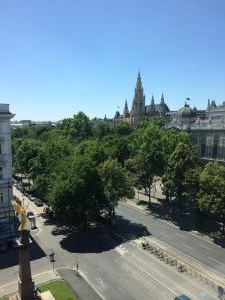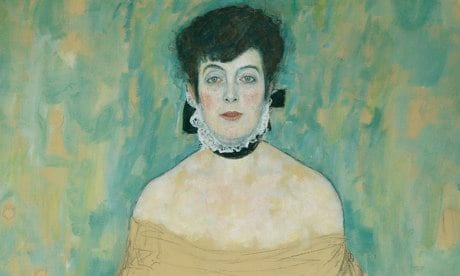Word came this week of two resolutions of claims to Nazi-looted art in museums in New York and Cologne, and a new Nazi-looted claim against Germany filed in Washington. Barely a month after the Neue Galerie (of Austrian and German art) in New York announced that it had discovered a “major work” in its collection had a clouded history, the museum announced an agreement concerning the Karl Schmitt-Rotloff painting Nude (1914). It is not known if the Schmitt-Rotloff is the same work to which the museum referred last month. Around the same time, the Wallraff-Richartz-Museum in Cologne, Germany, announced that it had agreed to return a drawing by Adolf Menzel that had been sold to Hildebrand Gurlitt as its owners fled Nazi Germany in the 1930s. Blick über die Dächer von Schandau (View over the rooves of Schandau) (1886) will be retuned to the heirs of Hamburg attorney Albert Martin Wolffson and his daughter Elsa Helene Cohen. These settlements are examples of constructive dialogue and enlightened treatment of the historical fact. The new litigation likely means the opposite approach from the German defendants.
Restitution Claims Resolved in New York and Cologne, New Case Filed Against Germany
Topics: Cologne, Schwabinger Kunstfund, Breslau, Gurlitt Task Force, Germany, Wallraf-Richartz Museum, Nazi-looted art, 28 U.S.C. 1605(a)(3), Gurlitt, David Toren, Neue Galerie, Ernst Ludwig Kirchner, New York, Karl Schmitt-Rotloff, Alfred and Tekla Hess, Streen Scene in Berlin, Adolf Menzel, Strassenzene
The Woman in Gold: Why the Altmann Case Matters
The release last week of The Woman in Gold, the feature film adaptation of The Lady in Gold by Anne Marie O’Connor, starring Helen Mirren and Ryan Reynolds as Maria Altmann and her attorney E. Randol Schoenberg, respectively, as well as Tatiana Maslany as the younger Altmann and Daniel Brühl as Austrian journalist Hubertus Czernin, is an important opportunity to reflect on the legal importance of the case. Even today, the case provides lessons about the way some victims are still treated, and how one individual can make sure the past is never forgotten. The looting of Jewish art collections was a concerted effort whose prominence should never be forgotten. And perhaps even more, it robs those who did survive of the dignity of remembering their family experiences. Consider: the next time you gather with your extended family, look around the room. Pick something that you’re accustomed to seeing when the family meets. Now, imagine it had been stolen or surrendered under duress, and was hanging on the wall of a national collection that denied it had been taken. How would you feel? This is the dilemma faced by many claimants, and it is precisely why Altmann matters so much.
Topics: Maria Altmann, The Lady in Gold, Adele Bloch-Bauer, The Woman in Gold, Daniel Brühl, Germany, Nazi-looted art, Academy of Fine Arts, Foreign Sovereign Immunities Act, Hitler, Tatiana Maslany, Anne Marie O’Connor, Supreme Court, A Few Good Men, Belvedere, E. Randol Schoenberg, World Jewish Congress, Stiftung Preussischer Kulturbesitz, Ryan Reynolds, FSIA, expropriation exception”, Restitution, Neue Galerie, World War II, Foreign Sovereign Immunities, Switzerland, Ferdinand Bloch-Bauer, Helen Mirren, Museums, Fritz Altmann, Gustav Klimt, Vienna, Welfenschatz, Hubertus Czernin, Ronald Lauder, Austrian National Gallery
Curiouser and Curiouser: Still More Gurlitt Paintings Found, Nazi-Looting Connections Unknown
As if the Cornelius/Hildebrand Gurlitt saga needed any more complications as the world awaits the official decision by the Kunstmuseum Bern about whether to accept the appointment as Cornelius Gurlitt’s heir, even more artwork has apparently turned up. Der Spiegel, the Frankfurter Allgemeine Zeitung, and the Wall Street Journal have reported that one picture and several sculptures in the very apartment from which the original trove was seized more than two years ago. Among the sculptures are apparently a Degas and a Rodin. Nothing else seems known about the works or their ownership history, or whether they might be among works that Hildebrand Gurlitt sold or acquired as "degenerate" (side note: the Victoria and Albert Museum's copy of the Degenerate Art Action register is currently on display in New York at the Neue Galerie's exhibition of that title. While it is available online, it is most certainly worth a visit before the show ends).
Topics: Frankfurter Allgemeine Zeitung, Victoria and Albert Museum, Rodin, Cornelius Gurlitt, Schwabinger Kunstfund. Kunstfund München, Gurlitt Task Force, Fall Gurlitt, Gurlitt Collection, Degas, Hildebrand Gurlit, Entartete Kunst, Gurlitt, Restitution, Bavaria, Neue Galerie, Der Spiegel, Wall Street Journal, World War II, Degenerate Art Action, degenerate art, Kunstmuseum Bern, www.lostart.de, Nazi art, Raubkunst
Dispute Over "Portrait of Amalie Zuckerkandl" on Loan to National Gallery—Calls for Restitution Put International Respect for Final Judicial Awards, Other Claims, at Risk
A recent loan to the National Gallery in London has grabbed headlines discussing the history of the painting, Portrait of Amalie Zuckerkandl, by Gustav Klimt, surrounding World War II and the persecution of Jews in Austria. Somewhat puzzlingly, the coverage has downplayed the fact that that very painting was already the subjective of an exhaustive proceeding in Austria that denied restitution, a decision reviewed and affirmed by the Austrian Supreme Court (though, apparently, also the subject of more recent requests for reconsideration). Should a claim for restitution or seizure be filed while the painting is outside Austria, in the UK or the US, it could have a troubling effect on respect for final judgments, as well as unintended consequences for restitution claimants who may find their judgments collaterally attacked elsewhere. As difficult as it may seem, the painting cannot be disturbed without putting a great deal more at risk.
Topics: Maria Altmann, Portrait of Adele Bloch-Bauer, Jonathan Jones, National Gallery London, the Guardian, Vita Künstler, Dr. Erich Führer, Beethoven Frieze, Belvedere, the United Nations Convention on the Recognition a, Jugendstil, Portrait of Amalie Zuckerkandl, Hermine Müller-Hofmann, Amalie Zuckerkandl, Restitution, Neue Galerie, World War II, Foreign Sovereign Immunities, Facing the Modern: The Portrait in Vienna in 1900, Kokoschka, Secession, Secession Museum, Austria, Ferdinand Bloch-Bauer, Fin de siècle, Gustav Klimt, Vienna, Anschluss, UNCITRAL





